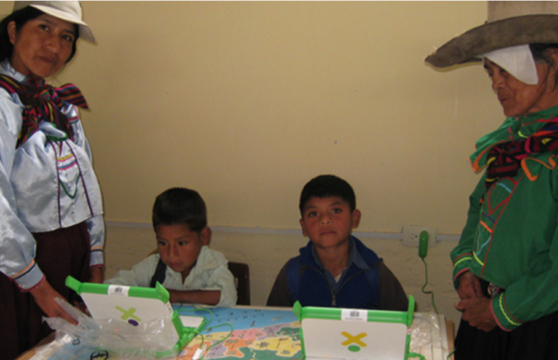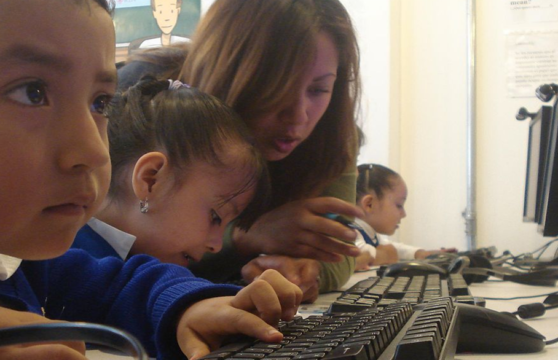
To Guide or Not To Guide Technology Use
Have investments in technology for Latin American public schools produced the expected results on student learning?
This post is also available in: Spanish
Over the last decade, access to education has improved significantly in Latin America. However, the same cannot be said for the quality of education in the region. Despite the progress made in increasing the years of schooling that students complete, the low performance of the region on the most recent PISA assessment highlights the gap in the development of skills. The low level of academic, technical, and socio-emotional competencies in Latin American countries poses a challenge not only for individual success in the labor market but also for national productivity.
Many Latin American countries have responded to this issue by implementing educational projects that incorporate technology as a means to improve the quality of education. A well-known example is the One Laptop per Child (OLPC) program, an initiative that seeks to expand access to technology and promote student-centered learning by giving school-aged children in developing countries a low-cost laptop. The OLPC program, a popular initiative with 17 active programs in Latin America, distributed 10 million portable computers throughout the region in 2014.
Despite the aggressive efforts of Latin American governments to increase access to technology in education centers, expanding access alone has not yielded positive results in academic performance. In a report by Elena Arias Ortiz and Julián Cristia, the authors refer to programs similar to OLPC as “non-guided,” being that they often do not provide learning objectives, content, or specific uses for the technology. Instead, these programs tend to solely focus on the distribution of computers and Internet connectivity. For example, the OLPC program in Peru increased the number of computers per student from 0.12 to 1.18 in participating schools, but an evaluation of the program revealed that there was no evidence that the program improved the students’ academic performance in math or reading. A primary reason for OLPC’s lack of success in Peru was that, aside from increasing access to technology, the program did not include specific learning objectives. Like most non-guided programs, the students were not using the computers to access content in an innovative way that would lead to meaningful learning experiences.
The poor results of non-guided projects similar to OLPC prompt the following questions: How can Latin American governments use technology in education more effectively? An example of a program that has been effective in improving English skills with technology is Ceibal en Inglés. While it is part of a larger OLPC program—Plan Ceibal—Ceibal en Inglés’ distinct structure has led to promising results and offers great lessons for the use of technology in education.
What is Ceibal en Inglés?
Ceibal en Inglés is a newer subprogram of the Plan Ceibal project, a nationwide OLPC initiative reduce the digital gap in Uruguay that recently celebrated its 10th anniversary. To support this goal, the project distributed inexpensive laptops to primary school children and connected all Uruguayan schools to the Internet. After 2009, Plan Ceibal expanded its platform to include several subprograms for different subjects such as reading, math, and more recently, English, which was called “Plan Ceibal en Inglés.” Unlike Plan Ceibal en Inglés, the reading and math programs have been less effective in improving primary school students’ skills. A 2013 study suggested that the programs did not have a significant impact on the students’ math and reading skills due to the students not using the laptops enough for subject-related activities. Instead, the students mostly used the laptops to collect information online and to navigate the Internet.
What made Ceibal en Inglés different, and more effective? It promoted a more efficient use of the laptops. In 2013, with the assistance of the British Council, an international organization that develops high-quality language learning material, Ceibal en Inglés made sure to integrate technology into English language learning and teaching experiences in a way adequately enhanced the English Language Learning experience.
In short, Ceibal en Inglés uses video conference technology to bring English teachers into Uruguayan classrooms remotely. Before Ceibal en Inglés, the shortage of qualified teachers in Uruguay meant that many students could not fulfill the mandatory English requirement. However, thanks to the model of Ceibal en Inglés, Uruguay was able to increase access to high-quality English lessons in public schools significantly. The program has grown at an impressive rate: from only 20 schools in the 2012 pilot project to 580 schools across all 19 departments in 2016. This growth means that 73% of 4th-, 5th-, and 6th-grade students are learning English through the video conference technology of Ceibal en Inglés.
What does it look in the classroom?
In the classroom, the implementation of Ceibal en Inglés involves a remote and a local teacher that work together to teach English three times a week. The teachers use a weekly cycle of detailed lessons developed by the British Council to structure their English sessions. The lesson plan, accessed through a learning management system called CREA, is divided into three lessons: A, B, and C. In Lesson A, the remote teacher teaches the topic to the students. Then in Lessons B and C, the local teacher uses a scripted lesson plan in Spanish to review the contents covered in Lesson A. Not only do the lesson plans help structure the English lessons, but they also guide the teachers on how and when to incorporate technology into their lessons.
Ceibal en Inglés uses technology in three different ways:
Does it work?
There have been several studies to evaluate the impact of Ceibal en Inglés. Two impact evaluations in 2013 and 2015 revealed a positive correlation between participation time in Ceibal en Inglés and English language learning skills. The 2013 study compared the reading, writing, and listening skills of 4th-6th-grade students who started the program six months earlier to those who had begun the program only three weeks before the study. The results revealed that students who completed a semester in Ceibal en Inglés scored 6.1 points higher in reading and 1.2 points higher in writing than students with less exposure to the program.
The 2015 study tested the reading, writing, and listening skills of 4th-, 5th-, and 6th-grade students from Ceibal en Inglés and Segundas Lenguas, an older English language program that only uses in-person instruction. The study revealed that students from both programs performed similarly in all three sections, despite the difference in exposure time to the English programs. Students from Ceibal en Inglés had up to three years of exposure, whereas the students from the Segundas Lenguas programs had up to seven years of exposure. The ability of Ceibal en Inglés students to perform similarly to students who may have been exposed longer to the English language highlights the program’s positive impact on improving the students’ English skills.
Lessons from Ceibal en Inglés
Ceibal en Inglés is an example of an effective intervention that made good use of technology in four different ways:
Ceibal en Inglés is an example of a guided use program that uses technology to improve the English proficiency level of students effectively. Its progress highlights the success of connecting access to technology to guided-use initiatives with specific learning objectives. It also serves as a model for other educational programs that are attempting to include technology in the program structure.
Image Credits: Learning with Ipads / Michel Coghlan / Flickr / CC by S.A-2.0
Have investments in technology for Latin American public schools produced the expected results on student learning?
Conference on technology in Latin American schools – takeaways to maximize the use of technology to improve learning.
Mexico’s government this month approved supporting secondary legislation that will provide additional direction for the country’s energy reforms.

